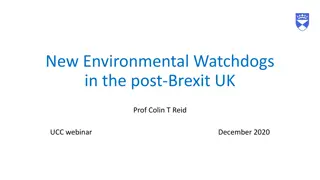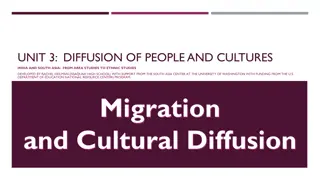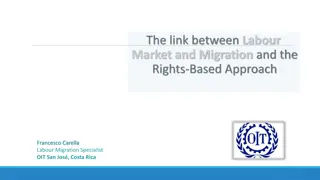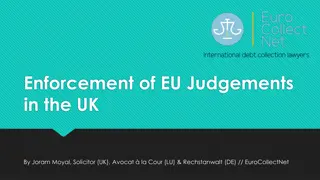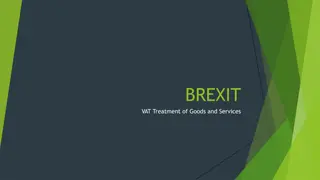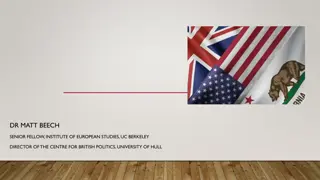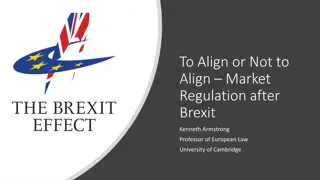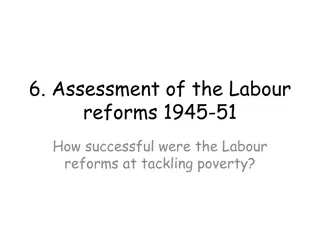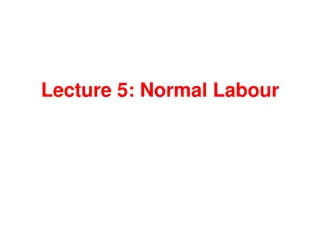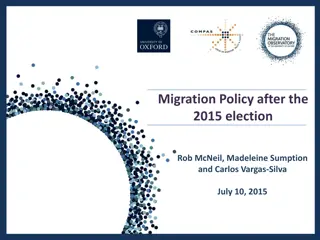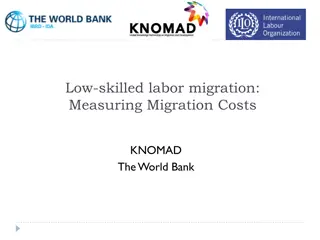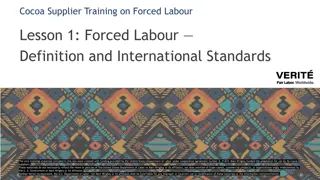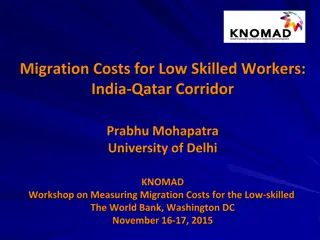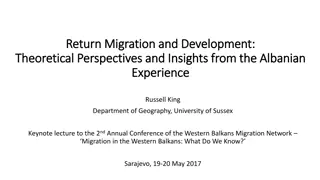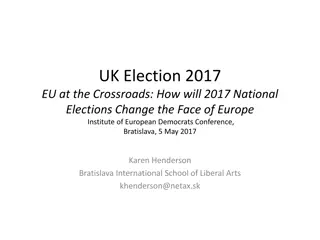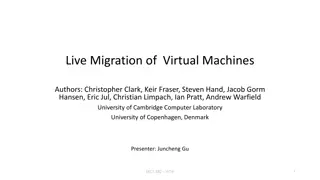Labour Migration Challenges Post-Brexit
Labour migration issues and their impact on employment standards post-Brexit are explored in this research, highlighting the evolving landscape of migrant employment in the UK and the implications for labor market flexibility. Factors driving migration trends and the role of flexible labor markets are analyzed, shedding light on the complexities of workforce dynamics in a changing regulatory environment.
Uploaded on Feb 24, 2025 | 1 Views
Download Presentation

Please find below an Image/Link to download the presentation.
The content on the website is provided AS IS for your information and personal use only. It may not be sold, licensed, or shared on other websites without obtaining consent from the author.If you encounter any issues during the download, it is possible that the publisher has removed the file from their server.
You are allowed to download the files provided on this website for personal or commercial use, subject to the condition that they are used lawfully. All files are the property of their respective owners.
The content on the website is provided AS IS for your information and personal use only. It may not be sold, licensed, or shared on other websites without obtaining consent from the author.
E N D
Presentation Transcript
1 Labour migration after Brexit: New questions, new answers? Bernard Ryan School of Law, University of Leicester br85@le.ac.uk Migration after Brexit: the challenge for labour standards Institute of Employment Rights: 15 March 2017
2 Migration and employment law after Brexit Previous Institute of Employment Rights work: Labour Migration and Employment Rights (September 2005) Background of optimism about openness to migration Labour migration in hard times: Reforming labour market regulation? (November 2013) Background of pessimism about migration policy - linked to numbers, austerity , policy on non-EU migration, doubts over EU membership Greater awareness of specific challenges in labour market: a legal right to work not a panacea; enforcement of contracts/ rights a key problem Implications of hard Brexit ? Pessimism over migration appears triumphant Majority of voters + Government giving up single market membership, in order to gain sovereignty over migration, accepted by Labour Party leadership Yet, significant migration is almost certain to continue Legal status of migrants likely to be weaker (temporary/ conditional work statuses) And: little prospect of strengthening of employment standards regime
3 Increase in migrant employment Employment by country of birth (LFS, United Kingdom, thousands) Change 1997-2016 Q1 1997 Q1 2004 Q4 2016 Total UK 26,245 24,323 1,921 7.32 638 2.43 565 2.15 28,327 25,738 2,593 9.15 746 2.63 620 2.19 31,916 26,369 5,543 17.37 2,304 7.22 929 2.91 1,336 4.19 3,239 10.15 + 5,672 + 2,046 + 3,622 + 10.05 + 1,665 + 4.79 + 365 +0.76 + 1,309 + 4.08 1,956 + 5.26 Non UK % EU27 % EU14 % Source: Labour Force Survey. United Kingdom. EU8+EU2 % 0.11 1,283 % 4.89 28 75 0.27 1,847 6.52 non-EU Increase in foreign-born employed of 3.6 million. Employment of UK-born has increased by 2 million. Foreign-born share of employed increased by 10%: 5% non-EU, 4% EU8+EU2, 1% EU14
4 What link to flexible labour market? Many factors contribute to the increase in labour migration: Increase in available labour abroad: skills, means to get here, legal rights in EU Ease of entry to labour market: English language + migrant networks Simply linked to expansion of economy (as it has grown, so has employment) Lack of British/ resident labour for less attractive work (ageing, education patterns, etc) International sectors requiring international labour Cost pressures in all sectors Post-1979 flexible labour market also plays a part: Emphasis on freedom of contract over core questions: pay/ time/ form of employment Rise in non-full-time work: part-time, agencies, zero-hours, labour-only self-employment. Tending to weaken de facto job security Collective bargaining/ trade union representation weaker and narrower Contracts and rights difficult to enforce (e.g. tribunal fees, lack of labour inspectorate) Weak regulation leaves employers freedom to take opportunities given by labour market - the availability of migrant labour is a major opportunity Enables expansion of certain forms of economic activity Migrants may be prepared to accept less attractive work, or poorer wage-work bargain, or may find it harder to enforce rights (for social and legal reasons)
5 Evidence concerning labour market impacts Migration Observatory (2014) shows high shares (30-40%) in lower-skilled process occupations, cleaning, food preparation/ hospitality. Also health professionals = 28% Qualitative evidence of employer preference for migrants in certain sectors Adams et al, Recruitment in Britain (2016, Equality and Human Rights Commission) No evidence of displacement effects in post-2008 recession: see Devlin et al (Home Office/ BIS, 2014). Some evidence of reduction in average wages, in lower-skilled occupations only: see Nickell and Saleheen (2015): suggest on average 10% increase leads to a 1% fall, rising to 1.8% in case of lower-skilled.
6 Perspectives on labour migration and employment regulation High Egalitarianism Rights of migrants to work and then to equal treatment Regulation of labour markets to benefit/ protect all workers Labour protectionism Labour market competition due to migration Regulation of labour markets to benefit/ protect British workers R E G U L Low High MIGR A T I O N TION Economic liberalism Labour supply benefits of migration Flexibility in labour markets Benefits to national workers as consumers Popular nationalism Costs of migration to identity/ social provision Regulation of labour markets (only) to prevent abuses Low
7 Three (unfashionable) perspectives Economic liberalism 1997-2016: dominant political outlook in relation to migration Emphasis on flexible labour supply from EU + selective migration for non-EU Concessions to public opinion: points-based system (2005-), employer civil penalties (2008), Conservative net migration target, Coalition reforms to labour migration (2011-2012) Employment law regime retained and expanded in parts (minimum wage) Egalitarianism Accepts legitimacy of migration for work, and seeks equality of treatment (legally and defacto) in labour market Miliband-led Labour Party advocated labour market reform within migration policy debate (2012-2015), focused on avoiding pressure on wages and conditions. Labour protectionism Seeks to limit migration and toregulate to protect national workers Remains present within Labour Party/ trade unions (e.g. Labour leave )
8 and a fourth which currently dominates Contemporary/ popular nationalism Emphasis on migration s damage to communities and social costs Theresa May, Conservative Party, 6 October 2015: when immigration is too high, when the pace of change is too fast, it s impossible to build a cohesive society. It s difficult for schools and hospitals and core infrastructure like housing and transport to cope. And for people in low-paid jobs, wages are forced down even further while some people are forced out of work altogether. Consistent with selective and conditional labour migration policy. For example, since 2011 restrictions on settlement for Tier 2 economic migrants earning below 35,000 blocks route to full participation in labour market/ society Regulation focuses on abuse in employment and criminalisation: Modern Slavery Act 2015: offences including forced labour and trafficking for exploitation , which includes securing services by force, threats or deception Immigration Act 2016: Director of Labour Market Enforcement + renamed Gangmasters and Labour Abuse Authority
9 Further thoughts Pre-referendum My view was that employment law reform critical if a remain decision. Labour market regulation then the only way (1) to address labour market challenges of migration and (2) to promote public acceptance. That implied creative approach to (a) equal treatment and (b) raising of standards in labour market: e.g. collective agreements, de-casualisation, labour inspection ... currently High levels of labour migration likely to continue consensus on the need in many sectors (from agriculture, care work, hospitality, NHS, higher education, science, finance) Employment law reforms needed more than ever Sceptical that criminalisation approach of Immigration Act 2016 the way forward likely to address extremes, and not designed to protect workers as such Need for employment law values in design of immigration policy especially power to change employer, acquisition of indefinite leave Also, in shaping employer checks against irregular work by migrants these likely to become more significant, as number of migrants with full rights to work declines Politically, is it possible to move from nationalism to an egalitarian perspective?


